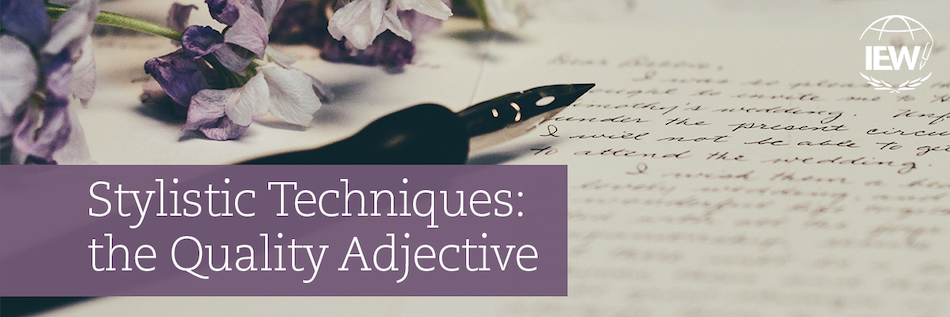
During the section of video instruction on key word outlines in Teaching Writing: Structure and Style, Andrew Pudewa relates parts of speech to describe people’s personalities. Verb people are those students who love (and often embody) vivid verbs. Tending to be the ones who would rather be building forts than writing reports, these are the students who often select verbs to place in their key word outlines. No nonsense noun people, on the other hand, prefer selecting nouns. Today’s blog post is dedicated to a third group of people, the artistic adjective people.
Adjectives are words that describe nouns or pronouns. As a stylistic technique, the student need only locate a noun within the paragraph and then add a word that describes it. Doing so, a dog suddenly can become a teacup dog, a junkyard dog, or a rescue dog. It can be an obedient dog, or, by adding a simple prefix, it morphs into a disobedient dog. The difference between the two animals is vast.
Adjectives are another tool in the Stylistic Techniques toolbox that helps students paint word pictures in their readers’ minds. Generally students find them easy to understand and add into their writing. For students who don’t have as robust a vocabulary, they sometimes need some support coming up with adjectives that really contribute to the sentence. In those cases there are a few things that can assist them. First off, get a hold of a handy thesaurus. IEW has a really nice one called A Word Write Now that students can use to help them hunt for words.
For those students who prefer a digital resource, check out IEW’s Writing Tools App. There are two versions: a free one and a low-cost one. The low-cost app includes a section called “Thematic Thesaurus for Stylized Writing,” featuring word lists separated by character traits, descriptive words, and words for movement and the senses. Looking through the section for adjectives under “Words to Describe Appearance,” you will discover words such as “bald,” “casual,” “ornate,” and “trendy,” just to name a few. Another great source for words is IEW’s Practical Printables word list page. Here’s a link to a word list that replaces the bland adjective “big.”
As with all dress-ups, the student indicates the quality adjective by underlining it. The rule is that there should be one underlined quality adjective in each paragraph of a composition. Brainstorm ideas with your students to front-load them with some word possibilities before you send them off to complete their compositions. With regular practice they will be adding adjectives without it being too hard. As always, follow EZ+1 in your teaching approach.
|
Jennifer Mauser has always loved reading and writing and received a B.A. in English from the University of Kansas in 1991. Once she and her husband had children, they decided to homeschool, and she put all her training to use in the home. In addition to homeschooling her children, Jennifer teaches IEW classes out of her home, coaches budding writers via email, and tutors students who struggle with dyslexia. |

